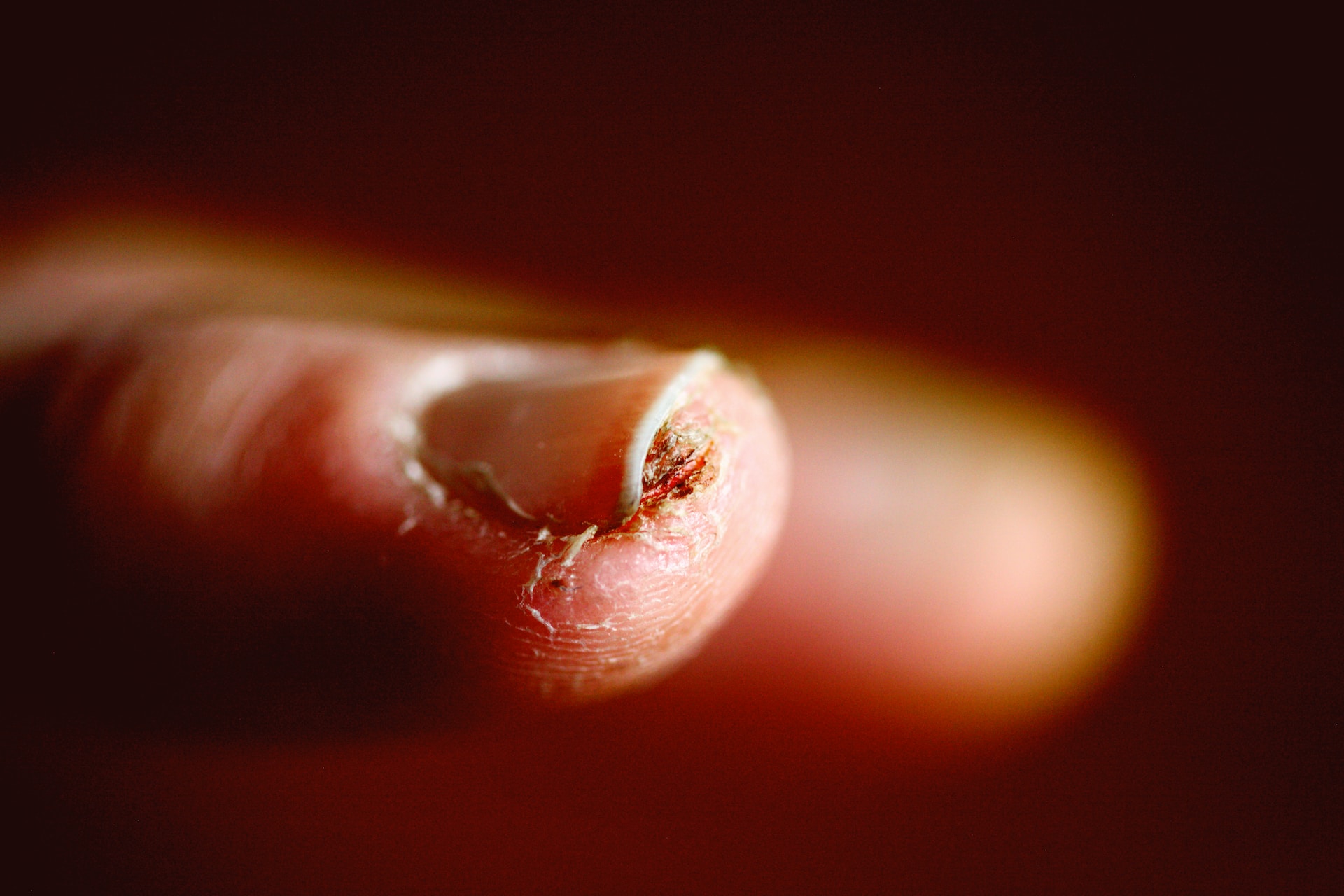
This comprehensive article on the signs, symptoms, causes, and treatment of ingrown fingernails is essential reading for anyone experiencing finger discomfort or seeking preventive measures. Whether you’re dealing with the initial stages of pain and tenderness or grappling with a full-blown infection, this guide offers valuable insights into identifying, preventing, and managing ingrown fingernails.
Everyone, from those with occasional nail discomfort to individuals prone to recurrent ingrown nails, will find practical information on best practices and home remedies to alleviate pain and promote healing.
Key Takeaways
- Ingrown fingernails manifest with pain, tenderness, redness, and swelling, with potential signs of infection.
- Causes include improper nail trimming, tight footwear, injuries, genetic predisposition, and underlying health conditions.
- Infections associated with ingrown fingernails include bacterial, fungal, paronychia, and cellulitis.
- Prevention involves proper nail trimming, choosing comfortable footwear, maintaining good hygiene, and avoiding trauma.
- Treatment options range from warm soaks and antibiotic ointments to professional intervention for severe cases.
- Home remedies include Epsom salt soaks, tea tree oil application, and cotton ball techniques to promote healing.
- Pain management strategies include over-the-counter pain relievers, cold compresses, elevation, and avoiding aggravating activities.
What is Ingrown Fingernail?
An ingrown fingernail, or onychocryptosis, is a condition where the fingernail edge grows into the surrounding skin, leading to pain, inflammation, and potential infection. Factors such as natural nail curvature, improper trimming, tight shoes, and trauma contribute to this condition. It causes irritation, and if bacteria enter, it may result in infection. Treatment involves soaking, lifting the ingrown edge, and maintaining cleanliness, while severe cases may require medical intervention. Prevention includes proper nail care and wearing comfortable shoes, and consulting a healthcare professional for persistent issues is advisable.
Signs and Symptoms for Ingrown Fingernail
Ingrown fingernails commonly present with pain, tenderness, swelling, redness, and, in severe cases, signs of infection such as pus and warmth around the affected area.
- Pain and Tenderness:
- The most common symptom of an ingrown fingernail is pain and tenderness along the affected nail edge.
- The pain is often exacerbated by pressure on the fingertip or when using the affected finger.
- Redness and Swelling:
- The surrounding skin may become red and swollen due to irritation caused by the ingrown nail.
- Inflammation is a natural response of the body to the perceived injury.
- Infection:
- If left untreated, an ingrown fingernail can become infected.
- Symptoms of infection may include increased pain, pus drainage, and the formation of an abscess.
- Changes in Nail Appearance:
- The affected nail may show signs of changes, such as discoloration or an abnormal shape.
- In severe cases, the nail may develop a curve, worsening the ingrowth.
What Can Cause Ingrown Fingernail?
Improper nail trimming, tight footwear, injuries, and genetic predisposition are common causes of ingrown fingernails.
- Improper Nail Trimming:
- One of the primary causes of ingrown fingernails is improper nail trimming.
- Cutting nails too short or rounding the edges can encourage the nail to grow into the adjacent skin.
- Tight Footwear:
- Wearing tight gloves or having a consistently tight grip on tools can compress the fingers and contribute to ingrown nails.
- Injury or Trauma:
- Physical trauma to the nail or finger can lead to changes in nail growth patterns, increasing the risk of ingrown nails.
- Genetic Predisposition:
- Some individuals may be genetically predisposed to ingrown nails due to the shape and structure of their nails.
- Underlying Health Conditions:
-
- Certain medical conditions, such as fungal infections or nail disorders, can alter nail growth and increase the likelihood of ingrown nails.
-
Infections Associated With Ingrown Fingernail
An ingrown fingernail infection occurs when a nail edge grows into the surrounding skin, causing pain, swelling, and potential infection. Improper trimming or tight footwear can contribute. Prompt attention, proper hygiene, and sometimes medical intervention are crucial to alleviate discomfort and prevent complications.
- Bacterial Infections:
- Ingrown fingernails provide an entry point for bacteria, leading to bacterial infections.
- Common bacteria involved include Staphylococcus aureus.
- Fungal Infections:
- Fungal infections can occur concurrently with ingrown nails, especially if there is damage to the nail plate.
- Candida species are often responsible for fungal infections in this context.
- Paronychia:
- Paronychia is an infection that occurs around the nail fold and can develop in association with ingrown fingernails.
- It may present with redness, swelling, and the formation of pus.
- Cellulitis:
- Untreated infections can lead to cellulitis, a more severe skin infection that can spread beyond the immediate area of the ingrown nail.
How To Prevent Ingrown Fingernail?
Prevent ingrown nails by cutting nails straight across, wearing comfortable footwear, maintaining good hygiene, and avoiding trauma to the nails.
- Proper Nail Trimming:
- Trim your nails straight across to avoid creating sharp edges that may dig into the surrounding skin.
- Do not round the corners too closely; leave a bit of the white tip.
- Avoid Trauma:
- Be cautious to prevent trauma to the fingers and nails.
- Protect your hands during activities that may increase the risk of injury.
- Choose Proper Footwear:
- Ensure that your gloves fit comfortably without being too tight.
- Avoid footwear that squeezes the toes, as this can contribute to nail deformation.
- Maintain Good Hygiene:
- Keep your hands and nails clean to reduce the risk of infection.
- Dry your hands thoroughly after washing.
- Moisturize:
- Use a moisturizer on the skin around your nails to prevent dryness and cracking.
How is Ingrown Fingernail Treated?
Treatment options include warm soaks to reduce pain and swelling, applying antibiotic ointment, placing cotton under the nail, and using over-the-counter pain medication.
- Warm Soaks:
- Soak the affected finger in warm water for 15-20 minutes, 3-4 times a day.
- This helps reduce inflammation and softens the skin, making it easier to manipulate the ingrown nail.
- Cotton Wedge Technique:
- Place a small piece of cotton or dental floss under the ingrown edge to encourage the nail to grow over the skin.
- Change the cotton daily to prevent infection.
- Topical Antibiotics:
- Apply an over-the-counter antibiotic ointment to the affected area to prevent infection.
- Keep the area covered with a sterile bandage.
- Pain Relief:
- Over-the-counter pain relievers like ibuprofen or acetaminophen can help manage pain and reduce inflammation.
Ingrown Fingernail Removal
Professional removal by a healthcare provider or podiatrist may be necessary, and in severe cases, minor surgical procedures may be performed.
- Professional Intervention:
- For severe cases or if the ingrown nail is recurrent, seek professional help.
- A healthcare provider, such as a podiatrist or dermatologist, may perform a partial or complete nail removal.
- Partial Nail Avulsion:
- This procedure involves removing a portion of the ingrown nail while leaving the rest intact.
- Local anesthesia is typically administered for comfort.
- Complete Nail Avulsion:
- In more severe cases, the entire nail may need to be removed.
- This procedure is usually done under local anesthesia and may involve the use of a chemical to prevent regrowth.
- Post-Removal Care:
- Follow the healthcare provider’s instructions for post-removal care.
- Keep the area clean, apply any prescribed medications, and attend follow-up appointments as recommended.
Home Remedies for Ingrown Fingernails
Home remedies involve Epsom salt soaks, tea tree oil application, and avoiding aggravating factors to promote healing and prevent infection.
- Warm Water Soaks:
- Soak the affected finger in warm water for 15-20 minutes, 2-3 times a day.
- This helps soften the skin and reduce inflammation around the ingrown nail.
- Epsom Salt Soaks:
- Add a tablespoon of Epsom salt to warm water and soak your finger.
- Epsom salt can help reduce inflammation and promote healing.
- Cotton Ball Technique:
- Gently lift the ingrown edge using a sterile tweezers.
- Place a small piece of cotton under the lifted edge to encourage proper nail growth.
- Tea Tree Oil:
- Apply a diluted solution of tea tree oil (mix with a carrier oil) to the affected area.
- Tea tree oil has natural antibacterial properties that can help prevent infection.
- Over-the-Counter Creams:
- Use over-the-counter antibiotic ointments or creams to keep the area clean and reduce the risk of infection.
Pain Management for Ingrown Fingernails
Manage pain with over-the-counter pain relievers and by minimizing pressure on the affected finger, such as wearing loose-fitting gloves.
- Over-the-Counter Pain Relievers:
- Take non-prescription pain relievers like ibuprofen or acetaminophen as directed.
- These medications can help alleviate pain and reduce inflammation.
- Cold Compress:
- Apply a cold compress or ice pack wrapped in a thin cloth to the affected finger.
- This can help numb the area and reduce swelling.
- Elevate the Finger:
- Elevate the affected hand to reduce blood flow to the ingrown nail.
- This may help alleviate pain and swelling.
- Avoid Aggravating Activities:
- Minimize activities that put pressure on the affected finger, such as typing or using tools.
- Rest the hand to prevent further irritation.
- Topical Anesthetics:
- Over-the-counter topical anesthetics may provide temporary relief.
- Follow product instructions and apply as directed.
When to Seek Professional Help?
Remember, persistent or worsening symptoms should prompt consultation with a healthcare professional for proper diagnosis and treatment. Severe cases may require medical intervention.
- If home remedies and pain management techniques do not provide relief.
- If there are signs of infection, such as increased redness, swelling, or pus.
- If the ingrown nail is severe or recurrent.
Best Practices For Managing Ingrown Fingernail
- Proper Nail Trimming: Cut nails straight across, leaving a bit of the white tip to prevent sharp edges.
- Avoid Trauma: Protect hands during activities to prevent injury and trauma to the fingers and nails.
- Choose Proper Footwear: Ensure comfortable gloves and avoid tight footwear that contributes to nail deformation.
- Maintain Good Hygiene: Keep hands and nails clean, drying them thoroughly after washing, and moisturize to prevent dryness.
- Warm Soaks: Use warm water for 15-20 minutes, 3-4 times a day, to reduce pain and inflammation.
- Cotton Wedge Technique: Place cotton under the ingrown edge to encourage proper nail growth, changing it daily.
- Professional Intervention: Seek medical help for severe or recurrent cases, with options ranging from partial to complete nail avulsion.
Final Thoughts
In conclusion, understanding the signs, causes, and treatment options for ingrown fingernails empowers individuals to take proactive measures in preventing and managing this common ailment. By adopting proper nail care practices, maintaining good hygiene, and knowing when to seek professional help, one can alleviate pain, reduce the risk of infection, and promote overall finger health. This article serves as a comprehensive guide for individuals of all backgrounds, emphasizing the importance of timely intervention and adopting effective preventive measures.
Also Read: Beyond Evolution: Why We Have Toenails and Fingernails?
FAQs
- Q: What are the common symptoms of an ingrown fingernail?
- A: Common symptoms include pain, tenderness, redness, swelling, and, in severe cases, signs of infection.
- Q: What causes ingrown fingernails?
- A: Causes include improper nail trimming, tight footwear, injuries, genetic predisposition, and underlying health conditions.
- Q: How can I prevent ingrown fingernails?
- A: Preventive measures include proper nail trimming, choosing comfortable footwear, maintaining good hygiene, and avoiding trauma.
- Q: What infections are associated with ingrown fingernails?
- A: Infections include bacterial, fungal, paronychia, and cellulitis.
- Q: How are ingrown fingernails treated?
- A: Treatment options range from warm soaks and antibiotic ointments to professional intervention for severe cases.
- Q: What are some home remedies for ingrown fingernails?
- A: Home remedies include warm water soaks, Epsom salt soaks, cotton ball techniques, and tea tree oil application.
- Q: When should I seek professional help for an ingrown fingernail?
- A: Seek professional help for persistent or worsening symptoms, signs of infection, or severe and recurrent ingrown nails.
#IngrownNailAwareness #NailHealth #FingerCare #PreventIngrownNails #NailHygiene #PainManagement #HomeRemedies #NailTreatment #HealthyNails #PodiatryTips #FingernailWellness #IngrownNailPrevention #ProfessionalIntervention #NailPainRelief #FingernailEducation
Note: The information provided in this article is for educational purposes only and should not be taken as medical advice. For personalized health recommendations, it is always advisable to consult with a healthcare professional before incorporating any changes to your daily health routine.







No comment yet, add your voice below!